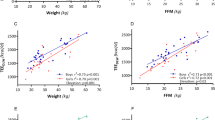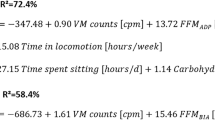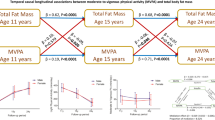Abstract
Objective:
To describe the design, measurements and fieldwork of the IDEFICS (Identification and prevention of dietary- and lifestyle-induced health effects in children and infants) physical activity and body composition validation study, and to determine the potential and limitations of the data obtained.
Design:
Multicentre validation study.
Subjects:
A total of 98 children from four different European countries (age: 4–10 years).
Methods:
An 8-day measurement protocol was carried out in all children using a collaborative protocol. Reference methods were the doubly labelled water method for physical activity, and a three- and a four-compartment model for body composition. Investigated field methods were accelerometers, a physical activity questionnaire and various anthropometric measurements.
Results:
For the validation of physical activity field methods, it was possible to gather data from 83 to 89 children, laying the basis for age- and sex-specific results. The validation of body composition field methods is possible in 64–80 children and allows sex-specific analyses but has only limited statistical power in the youngest age group (<6 years). The amount of activity energy expenditure (AEE) varied between centres, sexes and age groups, with boys and older children having higher estimates of AEE. After normalisation of AEE by body weight, most group-specific differences diminished, except for country-specific differences.
Conclusion:
The IDEFICS validation study will allow age- and sex-specific investigation of questions pertaining to the validity of several field methods of body composition and physical activity, using established reference methods in four different European countries. From the participant analyses it can be concluded that the compliance for the investigated field methods was higher than that for the reference methods used in this validation study.
This is a preview of subscription content, access via your institution
Access options
Subscribe to this journal
Receive 12 print issues and online access
$259.00 per year
only $21.58 per issue
Buy this article
- Purchase on Springer Link
- Instant access to full article PDF
Prices may be subject to local taxes which are calculated during checkout


Similar content being viewed by others
References
Bammann K, Peplies J, Sjöström M, Lissner L, De Henauw S, Galli C, on behalf of the IDEFICS Consortium et al. Assessment of diet, physical activity, biological, social and environmental factors in a multi-centre European project on diet- and lifestyle-related disorders in children (IDEFICS). J Public Health 2006; 14: 279–289.
Ahrens W, Bammann K, Siani A, Buchecker K, De Henauw S, Iacoviello L et al. The IDEFICS cohort: design, characteristics and participation in the baseline survey. Int J Obes 2011; 35 (Suppl 1): S3–S15.
Goran MI . Measurement issues related to studies of childhood obesity: assessment of body composition, body fat distribution, physical activity, and food intake. Pediatrics 1998; 101: 505–518.
Reilly JJ, Penpraze V, Hislop J, Davies G, Grant S, Paton JY . Objective measurement of physical activity and sedentary behaviour: review with new data. Arch Dis Child 2008; 93: 614–619.
Butte NF, Wong WW, Adolph AL, Puyau MR, Vohra FA, Zakeri IF . Validation of cross-sectional time series and multivariate adaptive regression splines models for the prediction of energy expenditure in children and adolescents using doubly labeled water. J Nutr 2010; 140: 1516–1523.
Eisenmann JC, Strath SJ, Shadrick D, Rigsby P, Hirsch N, Jacobson L . Validity of uniaxial accelerometry during activities of daily living in children. Eur J Appl Physiol 2004; 91: 259–263.
Ekelund U, Sjöström M, Yngve A, Poortvliet E, Nilsson A, Froberg K et al. Physical activity assessed by activity monitor and doubly labeled water in children. Med Sci Sports Exerc 2001; 33: 275–281.
Krishnaveni GV, Veena SR, Kuriyan R, Kishore RP, Wills AK, Nalinakshi M et al. Relationship between physical activity measured using accelerometers and energy expenditure measured using doubly labelled water in Indian children. Eur J Clin Nutr 2009; 63: 1313–1319.
Reilly JJ, Kelly LA, Montgomery C, Jackson DM, Slater C, Grant S et al. Validation of actigraph accelerometer estimates of total energy expenditure in young children. Int J Pediatr Obes 2006; 1: 161–167.
Bray GA, DeLany JP, Harsha DW, Volaufova J, Champagne CC . Evaluation of body fat in fatter and leaner 10-y-old African American and White children: the Baton Rouge Children's Study. Am J Clin Nutr 2001; 73: 687–702.
Eisenmann JC, Heelan KA, Welk GJ . Assessing body composition among 3- to 8-year-old children: anthropometry, BIA, and DXA. Obes Res 2004; 12: 1633–1640.
Elberg J, McDuffie JR, Sebring NG, Salaita C, Keil M, Robotham D et al. Comparison of methods to assess change in children's body composition. Am J Clin Nutr 2004; 80: 64–69.
Parker L, Reilly JJ, Slater C, Wells JC, Pitsiladis Y . Validity of six field and laboratory methods for measurement of body composition in boys. Obes Res 2003; 11: 852–858.
Prentice AM (ed). The doubly-labelled water method for measuring energy expenditure: A consensus report by the IDECG Working Group, NAHRES-4. International Atomic Energy Agency: Vienna, 1990.
Schofield WN . Predicting basal metabolic rate, new standards and review of previous work. Hum Nutr Clin Nutr Suppl 1985; 39/1: 5–41.
Westerterp KR . Diet induced thermogenesis. Nutr Metab 2004; 1: 5.
Burdette HL, Whitaker RC, Daniels SR . Parental report of outdoor playtime as a measure of physical activity in preschool-aged children. Arch Pediatr Adolesc Med 2004; 158: 353–357.
Gibson RS . Principles of Nutritional Assessment. 2nd edn. Oxford University Press: Oxford, New York, 2005.
Wells JC, Fuller NJ, Dewit O, Fewtrell MS, Elia M, Cole TJ . Four-component model of body composition in children: density and hydration of fat-free mass and comparison with simpler models. Am J Clin Nutr 1999; 69: 904–912.
Wells JC, Williams JE, Chomtho S, Darch T, Grijalva-Eternod C, Kennedy K et al. Pediatric reference data for lean tissue properties: density and hydration from age 5 to 20 y. Am J Clin Nutr 2010; 91: 610–618.
Tothill P, Hannan WJ, Wilkinson S . Comparisons between a pencil beam and two fan beam dual energy X-ray absorptiometers used for measuring total body bone and soft tissue. Brit J Radiol 2001; 74: 166–167.
Marfell-Jones M, Olds T, Stewart A, Carter L . International Standards for Anthropometric Assessment. ISAK: Potchefstroom, 2006.
Bland JM, Altman DG . Statistical methods for assessing agreement between two methods of clinical measurement. Lancet 1986; i: 307–310.
Cole TJ, Bellizzi MC, Flegal KM, Dietz WH . Establishing a standard definition for child overweight and obesity worldwide: international survey. BMJ 2000; 320: 1–6.
Cole TJ, Flegal KM, Nicholls D, Jackson AA . Body mass index cut offs to define thinness in children and adolescents: international survey. BMJ 2007; 335: 18.
Ekelund U, Yngve A, Brage S, Westerterp K, Sjöström M . Body movement and physical activity related energy expenditure in children and adolescents: How to adjust for differences in body size and age? Am J Clin Nutr 2004; 79: 851–856.
Colley R, Gorber SC, Tremblay MS . Quality control and data reduction procedures for accelerometry-derived measures of physical activity. Health Rep 2010; 21: 63–69.
Reilly JJ, Gerasimidis K, Paparacleous N, Sherriff A, Carmichael A, Ness AR et al. Validation of dual-energy x-ray absorptiometry and foot-foot impedance against deuterium dilution measures of fatness in children. Int J Ped Obes 2010; 5: 111–115.
Plasqui G, Westerterp KR . Physical activity assessment with accelerometers: an evaluation against doubly labeled water. Obes 2007; 15: 2371–2379.
Cliff DP, Reilly JJ, Okely AD . Methodological considerations in using accelerometers to assess habitual physical activity in children aged 0-5 years. J Sci Med Sport 2009; 12: 557–567.
Rennie KL, Wareham NJ . The validation of physical activity instruments for measuring energy expenditure: problems and pitfalls. Public Health Nutr 1998; 1: 265–271.
Hui SL, Gao S, Zhou XH, Johnston Jr CC, Lu Y, Gluer CC et al. Universal standardization of bone density measurements: a method with optimal properties for calibration among several instruments. J Bone Miner Res 1997; 12: 1463–1470.
Fan B, Lu Y, Genant H, Fuerst T, Shepherd J . Does standardized BMD still remove differences between Hologic and GE-Lunar state-of-the-art DXA systems? Osteoporos Int 2010; 21: 1227–1236.
Guolo A . Robust techniques for measurement error correction: a review. Stat Method Med Res 2008; 17: 555.
Stukal TA, Demidenko E, Dykes J, Karagas MR . Two-stage methods for the analysis of pooled data. Stat Med 2001; 20: 2115–2130.
Acknowledgements
We thank all members of the study teams and especially the children and their parents for their enthusiastic participation in the study. This study was conducted as part of the IDEFICS study (http://www.idefics.eu). We gratefully acknowledge the financial support of the European Community within the Sixth RTD Framework Programme under Contract No. 016181 (FOOD).
The information in this document reflects the author's view and is provided as it is.
Author information
Authors and Affiliations
Consortia
Corresponding author
Ethics declarations
Competing interests
MR has declared equity ownership/stock options with BioTel Ltd and Optimal Performance Ltd. The remaining authors declare no conflict of interest.
Additional information
Statement of ethics
We certify that all applicable institutional and governmental regulations pertaining to the ethical use of human volunteers were followed during this research. Approval by the appropriate ethics committees was obtained by each of the eight centres carrying out the fieldwork. Study children did not undergo any procedure before both they and their parents gave consent for examinations, collection of samples, subsequent analysis and storage of personal data and collected samples. Participating children and their parents could consent to single components of the study while abstaining from others.
Appendix: Outdoor playtime checklist (Burdette et al., 2004)
Appendix: Outdoor playtime checklist (Burdette et al., 2004)
How much time does your child usually spend per day playing in the yard or street around your house (or the house of a friend, neighbour or relative)?
Please indicate for every time frame.

How much time does your child usually spend per day at a park, playground or outdoor recreation area (for example, swimming pool, zoo or amusement park)?
Please indicate for every time frame. Include times that the child is at daycare, kindergarten, preschool or school.

Think for a moment about a typical weekday for your child in the last month. How much time would you say your child spends playing outdoors on a typical weekday?

Now think about a typical weekend day for your child in the last month. How much time would you say your child spends playing outdoors on a typical weekend day?

Rights and permissions
About this article
Cite this article
Bammann, K., Sioen, I., Huybrechts, I. et al. The IDEFICS validation study on field methods for assessing physical activity and body composition in children: design and data collection. Int J Obes 35 (Suppl 1), S79–S87 (2011). https://doi.org/10.1038/ijo.2011.38
Published:
Issue Date:
DOI: https://doi.org/10.1038/ijo.2011.38
Keywords
This article is cited by
-
Clustering of lifestyle behaviours and relation to body composition in European children. The IDEFICS study
European Journal of Clinical Nutrition (2015)
-
Blood pressure reference values for European non-overweight school children: The IDEFICS study
International Journal of Obesity (2014)
-
Adherence to the obesity-related lifestyle intervention targets in the IDEFICS study
International Journal of Obesity (2014)
-
The Association Between Childhood Stress and Body Composition, and the Role of Stress-Related Lifestyle Factors—Cross-sectional Findings from the Baseline ChiBS Survey
International Journal of Behavioral Medicine (2014)
-
Validation of anthropometry and foot-to-foot bioelectrical resistance against a three-component model to assess total body fat in children: the IDEFICS study
International Journal of Obesity (2013)



